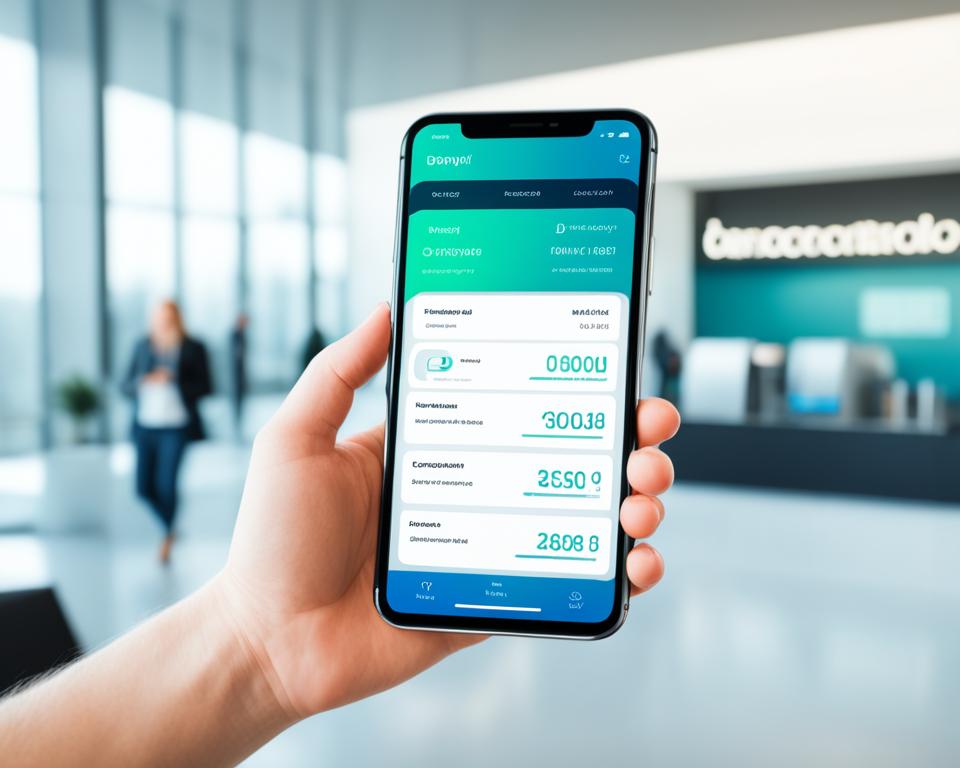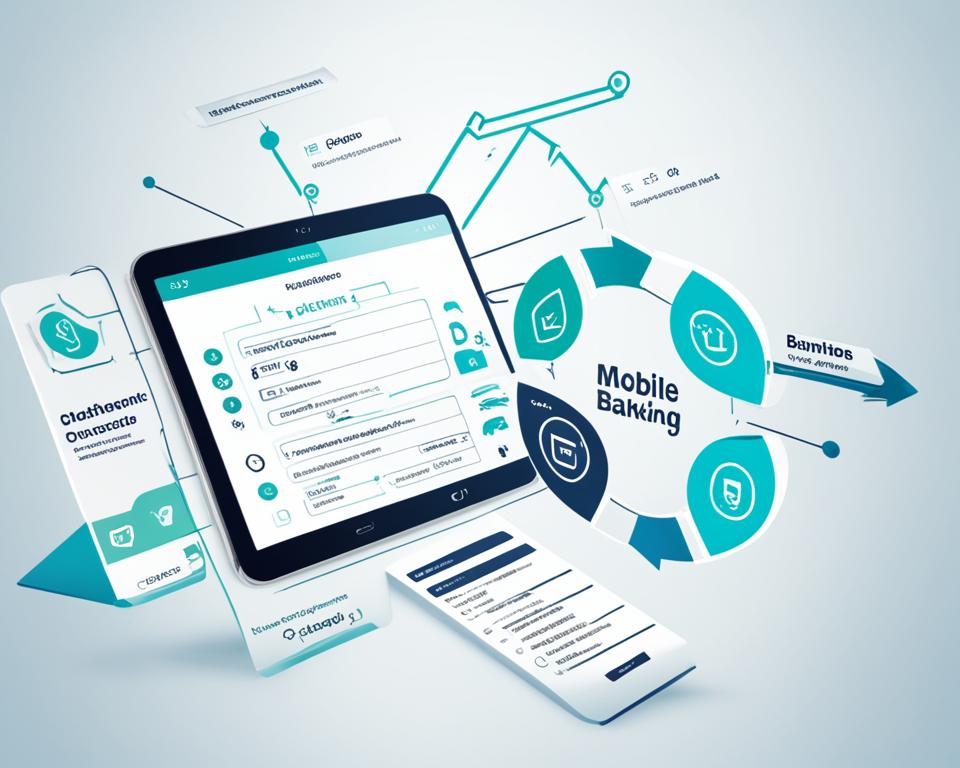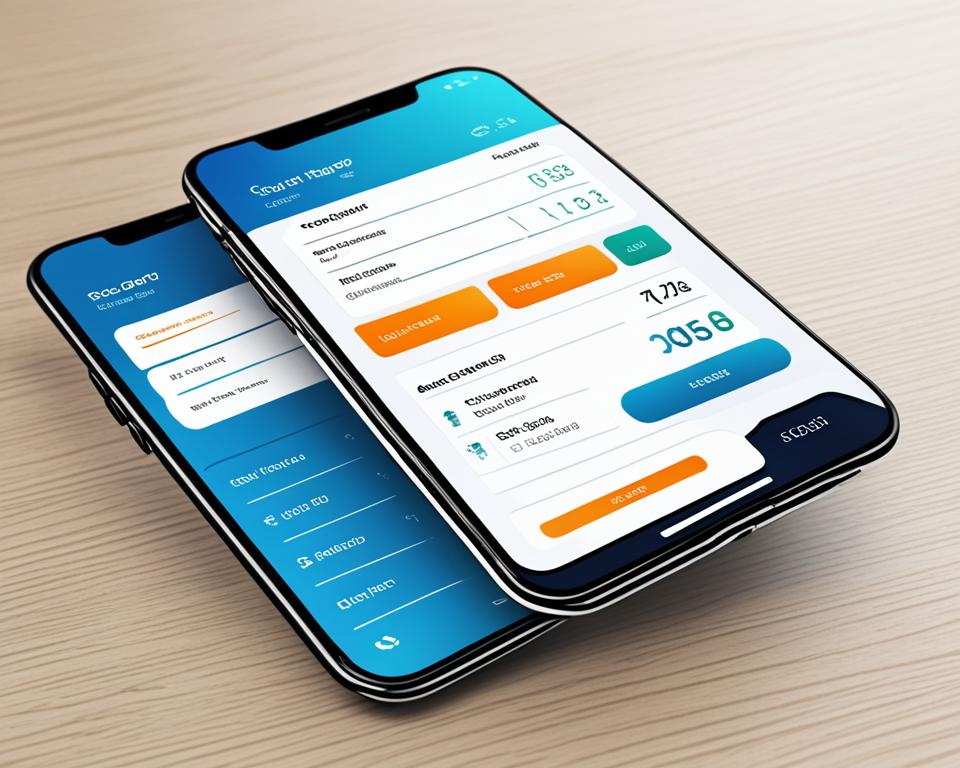In today’s world, we all want easy and quick ways to manage our money. That’s why making a great mobile banking app is key for banks. This guide will walk you through the steps and tips to make a top-notch mobile banking app.
First, we need to understand what makes mobile banking apps important. We’ll look at the features and functions needed for today’s banking customers. Then, we’ll talk about planning and choosing the best way to make your app.
Next, we’ll dive into the steps of building a mobile banking app. This includes working with back-end systems and making sure the app is tested well. We’ll also cover how to launch and keep your app up to date.
Finally, we’ll look at what’s coming next in mobile banking apps. By the end, you’ll know how to make a mobile banking app that will grab your customers’ attention and help your bank grow.
Table of Contents
Key Takeaways
- Understand the mobile banking app landscape and the importance of these applications in the modern banking ecosystem.
- Explore the key features and functionalities required to create a compelling and user-friendly mobile banking app.
- Learn about the strategic planning and development approaches to ensure a successful mobile banking app project.
- Discover the principles of designing an intuitive and secure user experience for your mobile banking app.
- Gain insights into the step-by-step process of mobile banking app development, including integration with backend systems and rigorous testing.
Understanding the Mobile Banking App Landscape
The mobile banking app market has grown a lot in recent years. This growth is thanks to more people using smartphones and wanting easy banking services. Now, banks see the value in making mobile banking apps that are easy to use and full of features.
Importance of Mobile Banking Apps
Today, mobile banking apps are key for people’s financial needs. They let users manage their money from anywhere, anytime. You can check balances, move money, and pay bills easily. Features like push notifications and secure payments make these apps even better.
Key Features and Functionalities
Good mobile banking apps have many features that meet different user needs. Some important features include:
- Intuitive account management tools
- Seamless fund transfers and bill payments
- Mobile check deposit capabilities
- Real-time account balances and transaction histories
- Personalized financial insights and budgeting tools
- Secure mobile payment options
- Convenient access to bank branch locations and ATMs
- Robust customer support features
These features make mobile banking apps essential for managing money easily. They help customers and keep banks competitive in the digital world.
“The future of banking lies in the palm of our hands, and mobile banking apps are at the forefront of this digital transformation.” – Financial Analyst, XYZ Research
Planning and Strategizing for Mobile Banking App Development
Creating a successful mobile banking app needs careful planning and a strategic view. You must understand your business goals, who will use the app, and the competition. Make sure your mobile banking app development strategy matches your bank’s digital growth plan. This ensures the app fits well and has a big impact.
Good planning for your mobile banking app means making a detailed plan, setting clear goals, and getting support from important teams like IT and marketing. Working together helps you spot and solve problems, use resources well, and make an app that your customers will love.
Managing stakeholders is key in this process. By talking with your stakeholders, you learn more, solve their issues, and build a common goal for the app. This teamwork is vital for overcoming the challenges of making a mobile banking app and giving users a smooth, safe experience.
“Successful mobile banking app development is not just about technical capabilities, but rather a harmonious integration of strategy, planning, and stakeholder collaboration.”
With a detailed plan and strategy, you can create a mobile banking app that achieves your business goals and pleases your customers. It will be easy to use and safe.
Choosing the Right Development Approach
Choosing the right way to make a mobile banking app is key. You have two main choices: native app development and cross-platform app development. Each has its own benefits and things to think about.
Native App Development
Native app development means making the app just for one platform, like iOS or Android. It uses the platform’s special features and design rules. This makes the app work better and look better too.
Native apps run smoothly and work well with device features. But, making them takes more time and money because you need different codes for each platform.
Cross-Platform App Development
With cross-platform app development, you make one app that works on many platforms, like iOS and Android. Tools like React Native, Flutter, and Xamarin help developers do this. This way, you can give users a similar experience on all devices.
This method can save time and money because you only need one codebase. But, these apps might not work as well as native apps in some cases.
When picking between native app development and cross-platform app development, think about what you need. Consider your target devices, how fast you need it done, your budget, and your team’s skills. Think about how important performance, user experience, and ease of development are to you. This will help you choose the best mobile banking app development approach for your project.
Designing an Intuitive and Secure User Experience
Making a mobile banking app that grabs users and keeps their info safe is key. It’s all about blending mobile banking app UI design and mobile banking app UX best practices. Also, adding robust security measures to protect mobile banking app data protection is vital.
User Interface Design Principles
Good mobile banking app UI design means being simple, consistent, and quick to use. A clean, easy-to-navigate interface lets users find what they need fast. Keeping the look and feel consistent across the app makes users feel at home.
It’s also important to make the app work well on different devices. This ensures a smooth experience no matter what device users have. Such attention to detail builds trust and confidence in the app.
Implementing Robust Security Measures
Keeping user data safe is crucial in mobile banking apps. Using mobile banking app security features like multi-factor and biometric authentication is key. These steps protect sensitive financial info from cyber threats.
Also, having real-time fraud detection helps catch and stop suspicious activities fast. This strong focus on mobile banking app data protection builds trust and makes the app more credible.
By balancing ease of use with strong security, mobile banking apps offer a safe way for users to handle their money. This approach gives users peace of mind and makes managing finances easier.
How to Develop a Mobile Banking App: Key Steps
Creating a successful mobile banking app takes a lot of work and planning. It starts with a great idea and ends with a well-made app. The mobile banking app development process has many steps, from the first idea to the final launch. By following a clear mobile banking app development lifecycle, apps can meet user needs and follow the rules.
Here are the main steps in making a mobile banking app:
- Requirements Gathering: Learn what the users need and what problems they face. Find out what features they want in a mobile banking app.
- Design and Prototyping: Make easy-to-use interfaces and prototypes to check if the app’s design works well.
- Development and Integration: Use the best technology to build the app. Make sure it works well with other systems and APIs.
- Testing and Quality Assurance: Test the app a lot to make sure it’s reliable and safe.
- Pre-Launch Preparations: Get the app ready for the app stores, make marketing materials, and follow the rules.
- Deployment and Launch: Put the app out there, watch for feedback, and fix any problems quickly.
By taking a step-by-step and careful approach, companies can make a mobile banking app that really helps customers. It will also follow the best practices and rules of the industry.
| Key Steps | Description |
|---|---|
| Requirements Gathering | Understand user needs, pain points, and desired functionalities. |
| Design and Prototyping | Create intuitive user interfaces and validate design through prototyping. |
| Development and Integration | Build the app using the right technology stack and integrate with backend systems. |
| Testing and Quality Assurance | Conduct comprehensive testing to ensure reliability, security, and performance. |
| Pre-Launch Preparations | Optimize the app for app store listings and ensure regulatory compliance. |
| Deployment and Launch | Release the app, monitor user feedback, and address post-launch issues. |
By following these steps in the mobile banking app development process, companies can make a mobile banking app that really helps customers. It will also set them up for success in the competitive mobile banking world.
Integrating with Backend Systems and APIs
For a mobile banking app to work well, it must connect smoothly with the bank’s backend systems and APIs. This part talks about how to do this right. It covers the key points and best ways to link the app with the bank’s core systems, CRM platforms, payment gateways, and other services. Making sure the app works well with mobile banking app backend integration, mobile banking app API integration, and mobile banking app data synchronization is key to a great mobile banking experience.
Linking the app to the bank’s systems is vital for getting to customer data, handling transactions, and keeping info up-to-date. This needs careful planning and setup to make sure data is safe, correct, and can grow with the app. Developers must check if the app’s mobile banking app API integration fits with the bank’s systems and APIs. This ensures data moves smoothly and users have a smooth experience.
Using the bank’s APIs, the app can tap into many features like managing accounts, transferring funds, paying bills, and giving financial insights. With mobile banking app data synchronization, users get the latest info and easy access to their financial details. This makes the app more useful.
For a good integration, developers need to think about data safety, how fast and big the app can grow, and how well it works. It’s important to use strong security like data encryption, more than one way to prove who you are, and safe ways to talk to the bank. This keeps customer data safe and builds trust in the app.
By linking the mobile banking app well with the bank’s systems and APIs, developers can make a strong and easy-to-use platform. This is a big step in making a successful mobile banking app that offers a smooth and safe way to bank.
Testing and Quality Assurance
To make sure a mobile banking app is reliable, secure, and follows the rules, testing and quality checks are key. This process covers both checking how the app works and finding security risks.
Functional Testing
Mobile banking app functional testing is vital to make sure the app does what it’s supposed to. It checks user flows, transactions, account management, and more. This way, developers can fix problems early on.
Security Testing
Mobile banking app security testing is also crucial to keep users and banks safe. It looks for ways to stop data breaches, unauthorized access, and malware. With strong mobile banking app quality assurance, apps can protect customer data and follow the rules.
A good testing plan looks at the app’s front-end, back-end, and how it connects with other systems. This helps find and fix problems in the whole mobile banking system. It makes sure users have a smooth and safe experience.
“Comprehensive testing is the foundation of a reliable and secure mobile banking app. It’s not just about checking boxes, but about delivering a truly exceptional user experience.”
Deployment and Launch Strategies
Launching a mobile banking app needs careful planning and action. Developers must make sure the app works well in app stores, fit for different places, and get the word out to users. This makes for a smooth experience for everyone.
Optimizing the app for app stores is key. It means making the app’s details, like its name, description, and pictures, better for finding in stores. Good app store optimization (ASO) helps more people find the app.
Localizing the app’s content is also vital. By making the app fit the needs and tastes of various places, banks can make it more appealing and useful to more people.
Marketing the app is essential for getting users. This can mean running ads, using social media, and working with influencers to create excitement. Starting with a small group of users can also help banks learn and improve the app before sharing it with everyone.
“Successful mobile banking app deployment requires a holistic approach that encompasses app store optimization, content localization, and strategic marketing efforts to drive user awareness and adoption.”
By carefully planning and doing these steps, banks can make sure their mobile banking app is easy to use and fun. This leads to happier customers and more loyalty.
Ongoing Maintenance and Updates
Keeping a mobile banking app up to date is key for its success. Banks use ongoing checks and analytics to see how users interact with the app. This helps them spot problems and learn what users want. They can then fix bugs and add new features to meet user needs and stay ahead.
Monitoring and Analytics
It’s vital to keep a close eye on how the app is doing. Banks look at things like how often users come back, how well they use the app, and how long they stay. This info helps them know what to improve and when to add new stuff.
Bug Fixes and Feature Enhancements
Fixing bugs and adding new features keeps the app competitive. It makes sure the app is easy to use, dependable, and has what users want. This leads to more people using the app and sticking with it.
| Metric | Importance | Insights Gained |
|---|---|---|
| User Retention | Shows how many users keep using the app over time. It tells us if the app is useful and valuable. | Helps find ways to make the app better and keep users interested. |
| Conversion Rate | Sees how many users do what the app aims for, like making a payment or signing up for a service. | Points out how to make the app better and use mobile banking app analytics to get more users to act. |
| Session Duration | Shows how long users spend in the app, which tells us how engaged they are and if the app is easy to use. | Shows what users do in the app and checks if the updates and maintenance work well. |
By always checking and improving their mobile banking apps, banks make sure users have a smooth, safe, and full experience. This keeps customers happy and coming back.
Compliance and Regulatory Considerations
Mobile banking apps are getting more popular, so following the rules is key. Making a mobile banking app means dealing with lots of laws about data privacy, financial rules, and cybersecurity best practices. This part talks about the main things you need to think about to make sure your mobile banking app is good to go and safe.
First off, mobile banking app data privacy is super important. Banks need to make sure they handle user data the right way, following laws like the GDPR and HIPAA. They must use strong encryption, keep data safe when sending it, and get users to agree to how their data is used.
Also, mobile banking app security standards must be kept up to fight off cyber threats. This means using things like biometric or multi-factor authentication, and always checking and updating the app’s security to keep up with new threats.
Financial institutions also have to follow special mobile banking app regulations, like the PCI DSS and GLBA. These rules are strict about keeping transactions safe, storing data right, and reporting things.
To make sure they follow all the rules, banks should work with legal and compliance experts from the start. This team will make sure the app meets all the rules, lowers risks, and stays good to go in the strict world of finance.
| Compliance and Regulatory Considerations | Key Requirements |
|---|---|
| Mobile Banking App Data Privacy |
|
| Mobile Banking App Security Standards |
|
| Mobile Banking App Regulations |
|
“Compliance and regulatory considerations are critical to the success and longevity of a mobile banking app. Partnering with subject matter experts can help ensure the app meets all necessary requirements and mitigates potential risks.”
Marketing and User Adoption Strategies
Getting people to use a mobile banking app takes smart marketing and keeping users interested. To get more people to know about and download the app, companies use many ways. This includes marketing in banks and on social media, plus referral programs and making the app stand out in stores.
But getting users to keep using the app is just as important. To keep a strong user base, it’s best to make the app easy to start using, send updates, and talk to users in the app. This keeps users happy and loyal.
Strategies for User Acquisition and Engagement
- Use in-branch marketing to teach customers about the app’s benefits and features
- Run targeted social media campaigns to reach new users and boost mobile banking app downloads
- Start a referral program that rewards users for inviting friends and family
- Make the app stand out in stores with smart keyword research and eye-catching visuals
- Give new users a personalized way to learn the app quickly
- Send push notifications and in-app messages to keep users updated and interested
By using these mobile banking app marketing and engagement strategies, banks can draw in new users and build a dedicated mobile banking app community.
“The key to success in the mobile banking app market is to create an engaging and user-friendly experience that keeps customers coming back time and time again.”
Future Trends and Innovations in Mobile Banking Apps
The future of mobile banking apps is set for big changes. New technologies and trends are making the user experience better. The mobile banking app industry is on the verge of a big change.
AI and machine learning are becoming more common in mobile banking apps. These technologies help give users real-time financial advice and make transactions smoother. They can also help with budgeting.
Augmented reality (AR) is another big change coming to banking apps. AR lets users see their finances in new ways. It could change how people use their banking apps.
Blockchain technology is also changing the mobile banking world. It makes transactions safer and more transparent. It also opens up new ways to lend and invest money.
Experts say mobile banking will focus more on personal finance and making things easier to use. They also see a push for more sustainable banking. By using data and analytics, apps can give users better advice to help them manage money better.
The mobile banking world is always changing. New tech, personal experiences, and sustainable banking are key trends. By using these changes, banks can offer customers secure, easy, and personal banking services.
Conclusion
Creating a successful mobile banking app takes a deep dive into the mobile banking world. It also needs a solid plan for making and improving the app. Plus, keeping an eye on user experience, security, and new ideas is key.
This guide shows how to make mobile banking apps that fit what customers want. It helps banks and financial groups stay ahead in the fast-changing digital banking world.
It’s all about setting clear goals, picking the right tech, and making the app easy and safe to use. Adding cool features like personalized info and mobile payments is also important. Plus, keeping data safe, offering great support, and testing well is crucial.
By focusing on these areas, banks can make apps that meet customer needs and help their business grow.
As more people want mobile banking, making apps that are secure, easy to use, and top-notch is key. Following the advice in this guide can help banks and financial groups succeed in the digital banking world.













